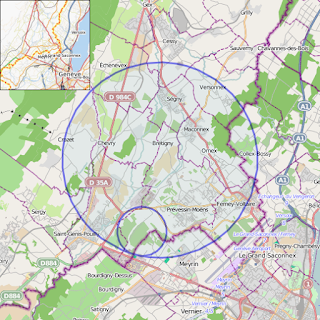The
Large Hadron Collider (LHC) is the world's largest and most powerful particle
collider, the largest, most complex experimental facility ever built, and the
largest single machine in the world.[1] It was built by the European
Organization for Nuclear Research (CERN) between 1998 and 2008 in collaboration
with over 10,000 scientists and engineers from over 100 countries, as well as
hundreds of universities and laboratories.[2] It lies in a tunnel 27 kilometres
(17 mi) in circumference, as deep as 175 metres (574 ft) beneath the
France–Switzerland border near Geneva, Switzerland. Its first research run took
place from 30 March 2010 to 13 February 2013 at an initial energy of 3.5
teraelectronvolts (TeV) per beam (7 TeV total), almost 4 times more than the previous
world record for a collider,[3] rising to 4 TeV per beam (8 TeV total) from
2012. On 13 February 2013 the LHC's first run officially ended, and it was shut
down for planned upgrades. 'Test' collisions restarted in the upgraded collider
on 5 April 2015, reaching 6.5 TeV per beam on 20 May 2015 (13 TeV total, the
current world record for particle collisions). Its second research run
commenced on schedule, on 3 June 2015.
Background
The
term hadron refers to composite particles composed of quarks held together by
the strong force (as atoms and molecules are held together by the
electromagnetic force). The best-known hadrons are the baryons protons and
neutrons; hadrons also include mesons such as the pion and kaon, which were
discovered during cosmic ray experiments in the late 1940s and early 1950s.
A
collider is a type of a particle accelerator with two directed beams of
particles. In particle physics colliders are used as a research tool: they
accelerate particles to very high kinetic energies and let them impact other
particles. Analysis of the byproducts of these collisions gives scientists good
evidence of the structure of the subatomic world and the laws of nature
governing it. Many of these byproducts are produced only by high energy
collisions, and they decay after very short periods of time. Thus many of them
are hard or near impossible to study in other ways.
Purpose
Physicists
hope that the LHC will help answer some of the fundamental open questions in
physics, concerning the basic laws governing the interactions and forces among
the elementary objects, the deep structure of space and time, and in particular
the interrelation between quantum mechanics and general relativity, where
current theories and knowledge are unclear or break down altogether. Data is
also needed from high energy particle experiments to suggest which versions of
current scientific models are more likely to be correct – in particular to
choose between the Standard Model and Higgsless models and to validate their
predictions and allow further theoretical development. Many theorists expect
new physics beyond the Standard Model to emerge at the TeV energy level, as the
Standard Model appears to be unsatisfactory. Issues possibly to be explored by
LHC collisions include:
v Are
the masses of elementary particles actually generated by the Higgs mechanism
via electroweak symmetry breaking? It is expected that the collider will either
demonstrate or rule out the existence of the elusive Higgs boson, thereby
allowing physicists to consider whether the Standard Model or its Higgsless
alternatives are more likely to be correct.
v Is
supersymmetry, an extension of the Standard Model and Poincaré symmetry,
realized in nature, implying that all known particles have supersymmetric
partners?
v Are
there extra dimensions, as predicted by various models based on string theory,
and can we detect them?
v What
is the nature of the dark matter that appears to account for 27% of the
mass-energy of the universe?
Other
open questions that may be explored using high energy particle collisions:
v It
is already known that electromagnetism and the weak nuclear force are different
manifestations of a single force called the electroweak force. The LHC may clarify
whether the electroweak force and the strong nuclear force are similarly just
different manifestations of one universal unified force, as predicted by
various Grand Unification Theories.
v Why
is the fourth fundamental force (gravity) so many orders of magnitude weaker
than the other three fundamental forces? See also Hierarchy problem.
v Are
there additional sources of quark flavour mixing, beyond those already present
within the Standard Model?
v Why
are there apparent violations of the symmetry between matter and antimatter?
See also CP violation.
v What
are the nature and properties of quark–gluon plasma, thought to have existed in
the early universe and in certain compact and strange astronomical objects
today? This will be investigated by heavy ion collisions, mainly in ALICE, but
also in CMS and ATLAS. Findings published in 2012 confirmed the phenomenon of
jet quenching in heavy-ion collisions, and was first observed in 2010



No comments:
Post a Comment